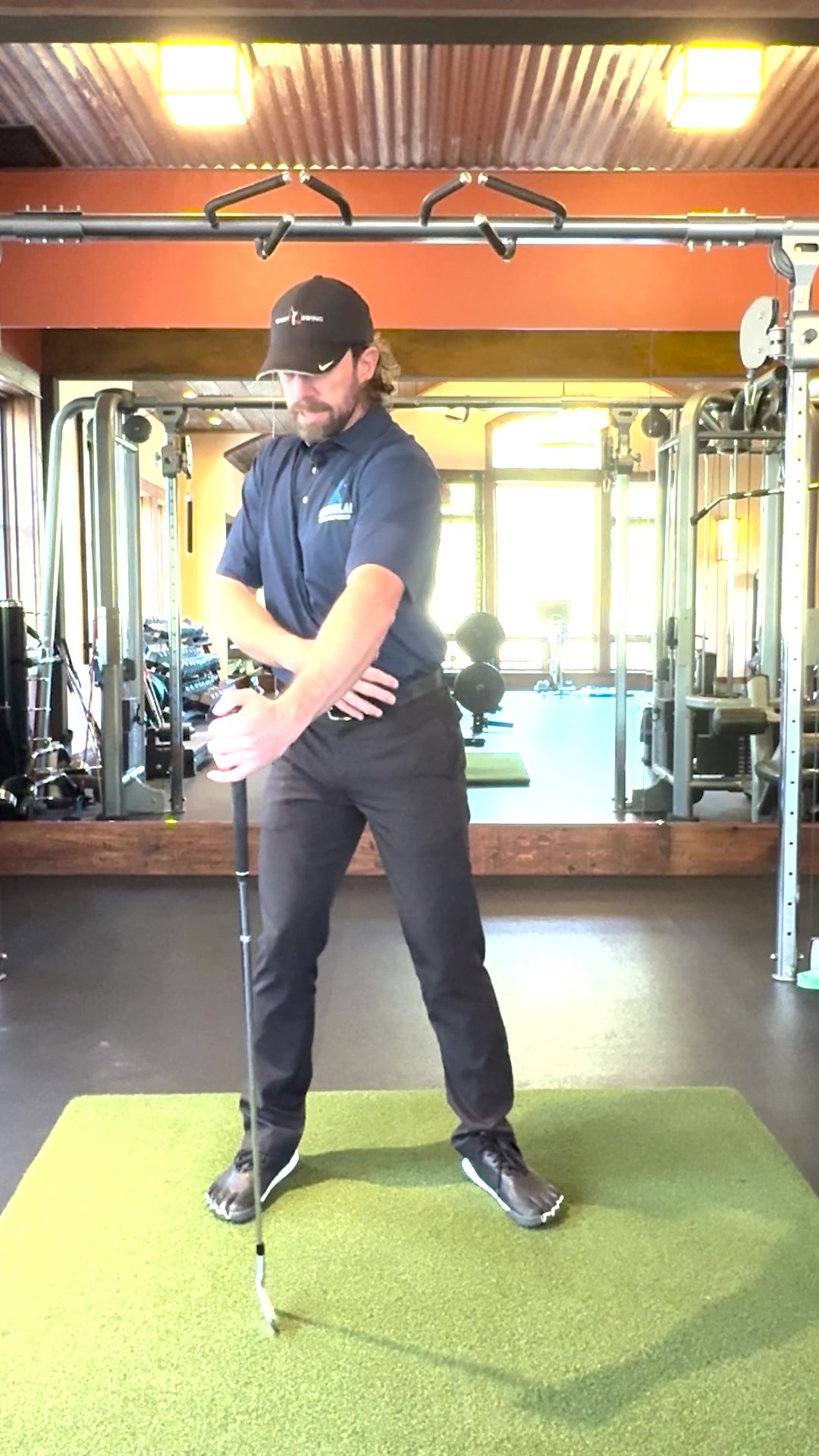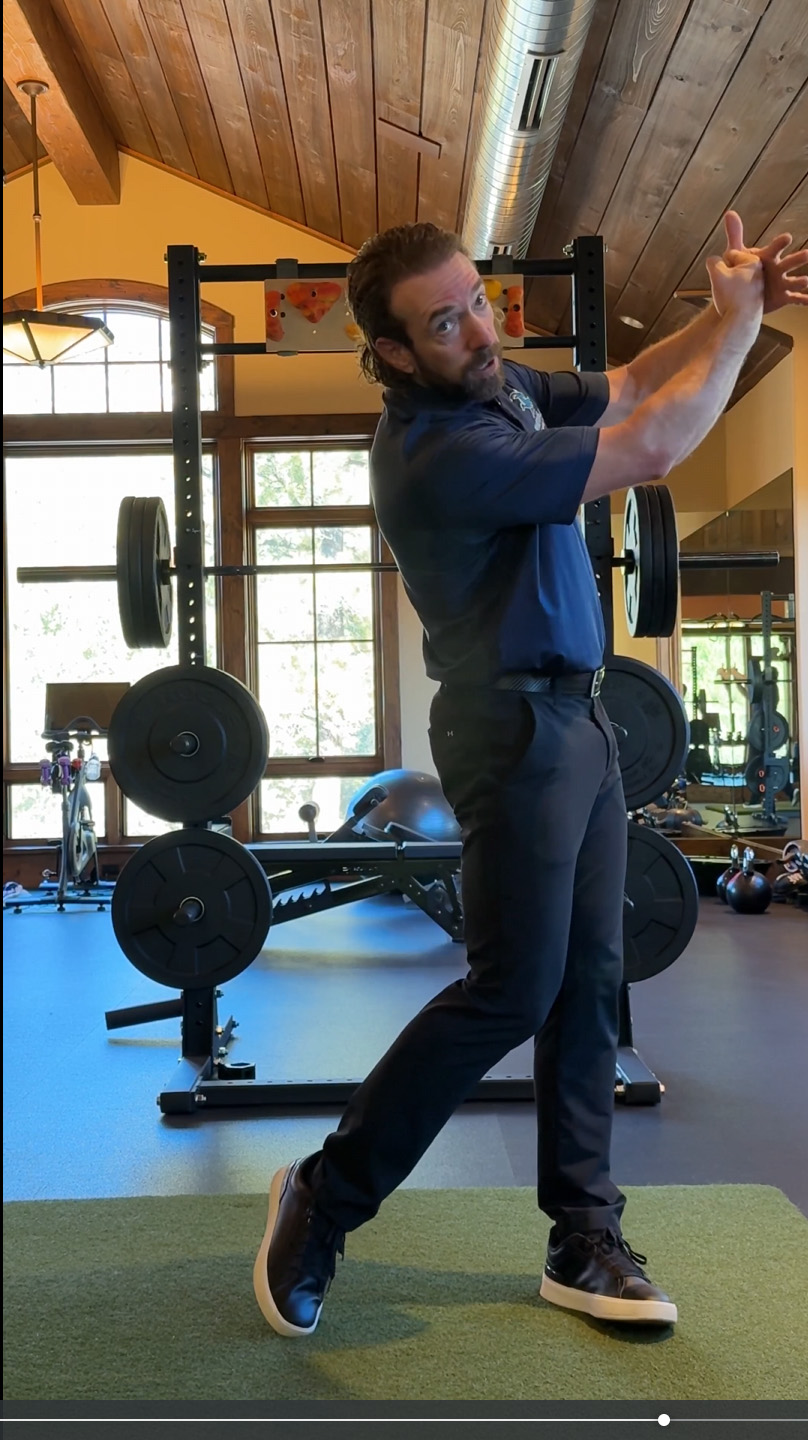Putter fitting has become an art and science all to itself. People spend lots of money to get properly fit for a putter, but the two most common problems don't require a visit to a high-end putting fitter.

The shaft can be aligned with the forearms in many ways; they're not all good!
The root of most putter fitting problems is that the shaft is not fit properly for the golfer. Probably 80% of the students we see are using putters that are too long. This causes two common problems, both related to setup.
Fortunately, you can diagnose this problem yourself, and you can even fix it yourself by cutting your putter shaft down to the correct length.
We talk a lot about getting the shaft aligned with the forearms, but there are many ways to do that.
You can get the putter shaft aligned with your forearms by bending way over and sticking your elbows out away from your body. You can stand up very straight and line them up.
Just because you've got that alignment doesn't mean you're necessarily in a good position.
Start With Good Posture

Elbow aligned with the center of the shoulder
As you know, to get into good putting posture you get your weight back on the center of your ankles and then hinge forward at the hips. Your rear will stick out a bit and your shoulders are back and down, connected to your core just like in the full swing.
The first thing you want to do when fitting a putter is get into your posture and make sure the center of your shoulder is aligned with your elbow.
As you hinge forward and hang your arms down, getting your elbow and shoulder aligned allows you to use your core to turn as you rock your shoulders back and through.

This putter is too long
Hang your arms down, then take your putting grip and check to see how much of the butt of the club sticks up between the heels of your hands.
In the photo at right Chuck Quinton is holding a 34" putter.
Chuck is fairly average height (5'9") and 34" or 35" is the most common putter length available off the shelf, but as you can see this putter is too long for Chuck.
You may well find the same thing. When you get into your posture, with good spine tilt and your elbows hanging out underneath your shoulders so you have room to swing, your putter may be too long.

Many golfers set up with the elbows out away from the body
Of course, everyone is different. If you have very short arms you may not have this problem, or if you have longer legs and a shorter torso.
Your ideal putter length will vary according to your build, but 80-90% of the time, we see golfers with clubs that are too long, setting up with their elbows way out away from their body, like in the photo at right.
Allowing the elbows to splay out like this totally disconnects you from your core so you can't rock your shoulders. You have all these different joints wanting to move all over the place.
Golfers in this position will argue that their forearms are still aligned with the club, but they're missing the point.
Try It and See
The whole idea is to get all your joints connected in neutral alignment so you can just rock your shoulders back and through without worrying about your wrists taking over and moving all over the place.

With elbows out, shoulders elevate & move freely
Stand up and see for yourself.
Get into neutral alignment, then move your elbows out. You'll feel your shoulders elevate, like in the photos at left. With your elbows out, now your shoulders can move freely.
Again, you want to make everything as simple and consistent as possible in the putting stroke.
Getting your elbows out like this in the putting setup activates those joints and gets them moving and, worse yet, it causes you to bend your wrists too much.
You might set up like that if you wanted to have a really wristy stroke like Jack Nicklaus and Arnold Palmer did back in the day, because it allows for a lot of wrist movement, but we don't recommend that for today's golfer.
Greens are much faster today, so you don't need to pop the ball. You need a much smoother, more subtle putting stroke, and you need to neutralize all these joints.
In the next photo, Chuck is chocking down on the grip so he can get into proper posture even with the longer club. Notice that his wrists don't have a lot of bend. He wants to prevent those joints from breaking down.

Wrists don't bend much
In a bad stroke, the hands are always the first thing to go.
In fact, that's all the yips are; you get handsy with it and don't trust what you're doing. If you take your hands out of the stroke, you don't have the yips anymore.
You can still kind of yip it or jab it with your shoulders, but there's no mental malfunction going on there; it's just not trusting what you're doing and stabbing at the ball.
You want to neutralize the wrists and elbow joints as much as possible. You don't want a lot of bend because the more you bend the more all these joints are going to want to move all over the place.
Now Check Your Own Putter

Then everybody ends up either gripping the end with their elbows bent, or standing up too straight where they don't get a good tilt with the elbows under the shoulders so they can't rock their shoulders properly.
The Second Problem: Lie Angle
The second most common problem is that the putter sits back with the toe way up off the ground.

Bad lie angle affects aim
This is a problem because your putter does have loft on it - it's not a lot, usually about 4° - but when you change the lie angle on any club, it ends up pointing off target.
If your putter sits way back on its heel the loft will actually cause it to point slightly left of where you're aiming. If it sits up on the toe it will point slightly right.
Putting requires precision that can come down to hundredths or even thousandths of an inch.
If your putter is too long and you get it sitting back on the heel, you may point it in the right direction but the face will be aiming off to the left, so there's no way you can actually start the ball exactly on your line.
You set up with the putter rocked back on the heel to compensate for the shaft being too long, then after a few strokes you find that everything you're hitting is going left so you start to hold the face open a little bit.
Once again, the length of your shaft is dictating what you're able to do with the putting stroke.
That's why the lie angle is one of the first things they check in a good putter fitting.

Get into alignment, then hinge forward (left, center). Don't round the shoulders (right)
Even if you have a bad setup, if you bend the club a little to correct the lie angle you can at least get the ball to start on line. But in an ideal world, why would we want to make compromises like that?
You still might need to get a little bend on your lie angle, but if you get your setup right first and use the right length shaft, then you're way ahead of the game because you won't have to make nearly as many adjustments.
Check Your Shoulders
Again, center yourself with your weight down through the ankles. Keep your shoulders back and down. Get your shoulders, elbows, hips, knees, and ankles all into alignment, then just hinge a little from the hips and let your arms hang down.

Rounded shoulders = longer arms (above); get a proper grip (below)
Don't let your shoulders get rounded forward because that will get your arms moving all over the place again.
Keep your shoulders pulled back and down. Your arms aren't just swinging freely; they're connected to your core.
Rounding the shoulders also effectively makes your arms longer. If your putter is too long, that's only going to make the problem worse.
When Chuck rounds his shoulders in the photo at left, you can see the full logo on the grip. When he pulls his shoulders up and back, his arms are pulled back as well.
This connects him to his core so he can just rock his shoulders instead of having his arms move all over the place. Getting set up correctly is everything.
Most people will end up having to cut their putters down a little bit.
You can choke up on it a little if you don't want to cut it for whatever reason, but the best thing you can do is find your perfect posture - shoulders back, arms hanging neutral - then if you find the putter shaft is too long just take an inch or so off of it.
This will help your putting stroke immensely. If you have a tendency to get wristy with it, or your elbows are disconnected from your body, you'll be far more consistent once you can let your arms hang down with just a slight neutral bend.
Fortunately, it's Easy to Fix
Check the length of your putter. Find out how much of the grip is sticking out when you're in good posture, then either take it to a club fitter or cut it down yourself.
Take a hacksaw to the end of the shaft, put a new grip on, and watch your putting improve.
Most people will do much better with a shorter putter than what they're currently using. Your putter may need to be cut down to get a custom fit, but it will make a big difference in your putting.
Checkpoints for Practice
- The two most common problems in putter fitting are shaft length and lie angle
- Getting into proper putting position - hinged forward, arms hanging down, shoulders down and back
- Taking your grip and check to see if the butt of the club protrudes between your hands
- Most golfers have putters that are 1" to 1.5" too long - cut it down yourself or take it to a fitter
- Also check lie angle - if the toe is up in the air, the loft on the face will send the ball left
Related RST/RS1 Articles & Videos:
Watch part 2 now to see how you're moving your body in the opposite direction of the pros!









































































































































































































 The shaft can be aligned with the forearms in many ways; they're not all good!
The shaft can be aligned with the forearms in many ways; they're not all good! Elbow aligned with the center of the shoulder
Elbow aligned with the center of the shoulder
 This putter is too long
This putter is too long Many golfers set up with the elbows out away from the body
Many golfers set up with the elbows out away from the body With elbows out, shoulders elevate & move freely
With elbows out, shoulders elevate & move freely Wrists don't bend much
Wrists don't bend much
 Bad lie angle affects aim
Bad lie angle affects aim Get into alignment, then hinge forward (left, center). Don't round the shoulders (right)
Get into alignment, then hinge forward (left, center). Don't round the shoulders (right) Rounded shoulders = longer arms (above); get a proper grip (below)
Rounded shoulders = longer arms (above); get a proper grip (below)
